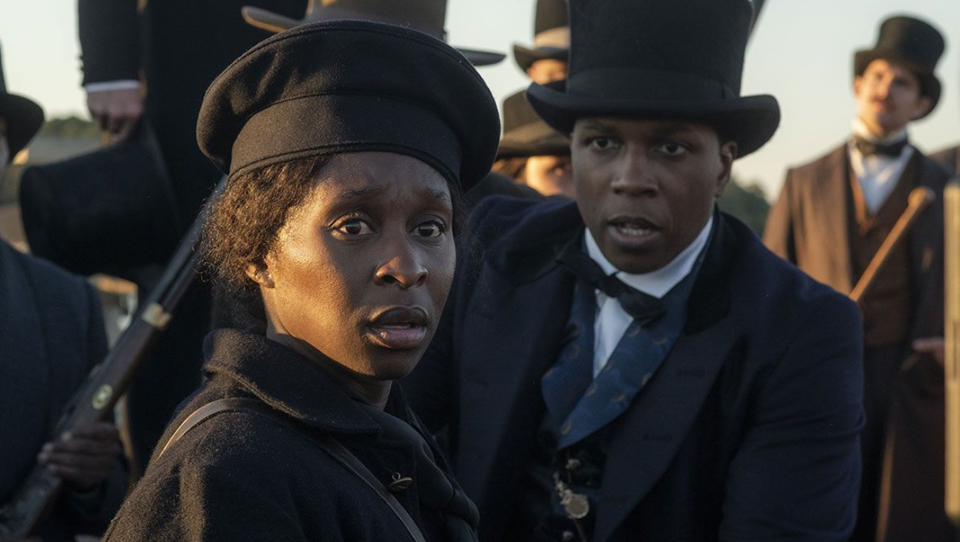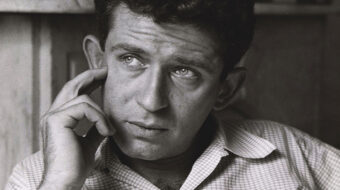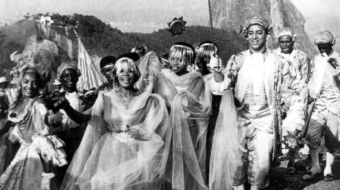
The stand-up-and-cheer biopic Harriet about legendary freedom fighter Harriet Tubman (British-born actress/singer Cynthia Erivo, who won the Best Leading Actress in a Musical Tony Award for The Color Purple in 2016) is arguably the most progressive feature film of the year.
In a straight forward, conventional manner co-writer/director Kasi Lemmons (1997’s Eve’s Bayou) unfolds the life story of Araminta “Minty” Ross, who was born into slavery circa 1822 in Maryland. The details of Minty’s tumultuous life are so dramatic that for the most part Lemmons doesn’t need to resort to cinematic flourishes to bring her story alive.
The film starkly portrays how monstrously cruel the “peculiar institution” of slavery truly was and demolishes the despicable, odious notion that humans can be owned by others.
In Harriet a picture emerges of a young highly determined woman who, against all odds, escapes from her plantation in Maryland and makes her way 100 miles north to “freedomland.” In Philadelphia Minty joins the Abolitionist movement co-led by William Still (Leslie Odom Jr.). Minty takes a new “freedomland” name – Harriet Tubman – and eventually decides to return south to help other slaves escape to the “promised land,” with assistance from those noble heroic rescuers, the Underground Railroad.
Tubman went on to become that clandestine network’s most famous “Conductor” on the freedom “train” bringing escaped slaves to the North. Although Harriet is focused on the title character, and Erivo delivers a powerhouse of a performance ranging from passion to poignancy to empowerment, one of the great things about this story is that it brings the abolitionists and Underground Railroad – the Left of their day – vividly alive.
In addition to Still, who is an important character in the movie, there are glimpses of orator/organizer Frederick Douglass (Tory Kittles), himself an ex-slave; Sen. William Seward (who went on to become President Lincoln’s Secretary of State); and John Brown (Nigel Reed), one of the greatest freedom fightere in American history.
Although Harriet covers a lot of ground, her role in Brown’s historic Harpers Ferry Raid is unfortunately not told in what is, nonetheless, a thrilling historical epic.
Harriet also gives us personal insight into Minty and her private life – as a wife, daughter, sister. In Lemmons’ nearly sole departure from her right-on-the-nose filmmaking, the dreamlike “visions” Harriet reportedly experienced are cinematically depicted in brief montage sequences.
Minty’s “master” threw a metallic object that struck her in the head. In this childhood incident she suffered a cracked skull that caused recurring hallucinatory ewpisodes for the rest of her life. (Still wryly observes that the escaped slave may have “brain damage.”) On screen Tubman ascribes her “premonitions” to God speaking with her, and on and off screen Harriet was a devoutly religious person.
Although, happily, Harriet wasn’t the “turn the other cheek” variant of a Christian, as hers was the Christianity of Liberation Theology, where those who struggle for justice inherit the earth.
In 1978 Cicely Tyson starred in A Woman Called Moses, a TV program about Tubman. But this is the first time a major movie has been made about this actual historical figure whose life is the very thing drama is made of – conflict, action, heroics. Really, the Greeks couldn’t have conjured up a better story. Eyeing the boffo box office of Black Panther, Hollywood now seems eager to emulate that success and to
tap into the ticket buying power of Black people. (Better late than never!)
Indeed, Harriet Tubman is a real life superhero and the film briefly follows her exciting exploits into the life the enslaved woman named Minty went on to live during the Civil War.
Towards the very end Lemmons treats us to another extremely cinematic shot, as Harriet participates in a naval invasion and the camera pauses on the land. What then follows may bring tears to your eyes, as it did to mine. And how Minty-cum-Harriet ended up may be the single most miraculous thing about her extraordinary singular life, which was so full of meaning
The outstanding cast includes veteran thespian Vondie Curtis-Hall as Rev. Greene; as Harriet’s dad Bob Ross, Clarke Peters injects some comic relief; singer/actress Janelle Monáe (2016’s Hidden Figures and Moonlight), who deserves a Best Supporting Actress Oscar nomination for her touching depiction of Marie Buchanon, a freed Black female entrepreneur who takes the newly freed fledgling Harriet under her wings at Philadelphia.
And speaking of Academy Awards, hopefully one of those coveted golden statuettes will be liberated by Ms. Erivo. She also merits an Oscar and Grammy for co-composing and performing Harriet’s beautiful theme song, “Stand Up.”
This two-hour five-minute dramatization of an African-American icon’s amazing life proves how Hollywood has missed out on so much by neglecting and misrepresenting the dramatic narratives of Black lives. Racism cheats us all.
Other historical figures like Robert Smalls – another real life superhero- are crying out for the big screen treatment. Any non-Black owned media outlet that regularly reviews films but overlooks Harriet is, at best, racially insensitive – if not outright racist.
In 1915 D.W. Griffith screened his racist epic The Birth of a Nation for his fellow Southerner Pres. Woodrow Wilson at the White House. The bigoted Wilson, who was also a historian, reputedly pronounced Griffith’s falsification and demonization of the antebellum, Civil War and Reconstruction eras to be “like watching history written with lightning.” Now, the oppressed are behind of and in front of the cameras, telling their side of the story – and what a glorious saga it is. To paraphrase Wilson, experiencing the movie Harriet is like watching history written with enlightening lightning.
This “Minty” is as delicious as mint tea. Harriet and the Revolution are coming soon to a theater near you. Don’t miss it. BRAVO!
Harriet opens wide on Nov. 1.
L.A.-based reviewer/film historian Ed Rampell co-authored “The Hawaii Movie and Television Book” available at: https://mutualpublishing.com/product/the-hawaii-movie-and-television-book/.












Comments